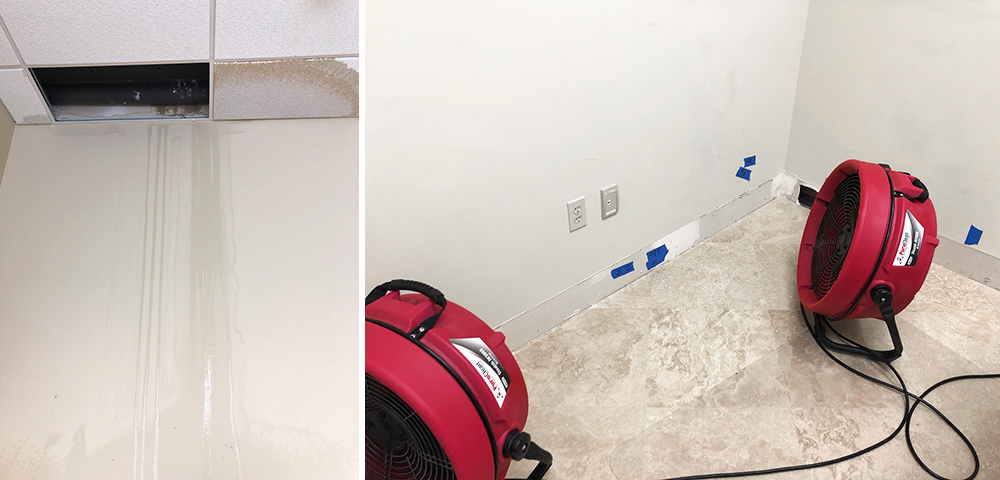Table of Contents
Water damage is one of the most costly and disruptive issues homeowners face. Whether it’s a slow leak under the sink or a sudden flood from a busted pipe, the damage can be extensive—and expensive. The good news? Most water damage is preventable. In this guide, you’ll learn how to protect your home from water damage with proven, proactive steps that can save you thousands of dollars and endless stress.
To protect your home from water damage, proactively inspect your roof, clean gutters, know shutoff valves, install leak sensors, maintain your sump pump, seal cracks, and winterize pipes. Early detection and timely maintenance are key.
1. Inspect Roof and Flashing Regularly
Your roof is your home’s first defense against rain, snow, and storm water. A missing shingle or cracked flashing can let in enough moisture to cause rot, mold, and insulation damage.
How often should I inspect my roof for water damage prevention?
At least twice a year—preferably in spring and fall. Use binoculars or hire a professional to check for damaged or missing shingles.
2. Keep Gutters & Downspouts Clean and Directing Water Away
Clogged gutters overflow and pool water around your foundation. That’s a recipe for water seepage into your basement or crawlspace.
- Clean gutters at least twice a year.
- Extend downspouts 4–6 feet from your home.
Can clogged gutters really cause basement flooding?
Yes. Overflowing gutters can direct water toward your home’s base, weakening the foundation.
3. Know and Utilize Water Shutoff Valves
If a pipe bursts, knowing where your main shutoff valve is—and how to use it—can prevent catastrophic flooding.
- Label shutoff valves clearly.
- Test them every few months.
Where is the main water shutoff valve usually located?
Near your water meter or where the main line enters the home (typically in a basement or utility area).
4. Install Leak Detection Sensors & Auto Shutoff Devices
Smart leak detection systems can alert you the moment moisture is detected—and some even shut off your water automatically.
- Place sensors near water heaters, under sinks, and behind washing machines.
- Use Wi-Fi-enabled sensors for remote alerts.
What’s the best leak detector for a modern home?
Systems like Flo by Moen or Honeywell Lyric are highly rated.
5. Maintain Your Sump Pump & Backup Power
If your basement floods during heavy rain, a sump pump can save the day—if it’s functioning.
- Test your sump pump every few months.
- Consider battery or water-powered backups.
How long does a sump pump typically last?
7–10 years with proper maintenance.
6. Seal Windows, Doors & Foundation Cracks
Water often seeps in through poorly sealed entry points. Use caulk or weather stripping to keep moisture out.
- Inspect annually.
- Use hydraulic cement for deeper cracks.
Can sealing small foundation cracks really help?
Absolutely. Small cracks can let in moisture over time, leading to major damage.
7. Winterize Pipes & Monitor Water Bills
Frozen pipes are among the leading causes of water damage during colder months.
- Insulate exposed pipes.
- Leave faucets dripping in freezing weather.
- Monitor your water bill for unexplained spikes.
How do I know if I have a hidden leak?
A sudden jump in your water bill often signals an unseen leak.
When to Call a Professional – PuroClean of Bellflower
Sometimes, prevention isn’t enough. If you’ve experienced a leak, flood, or signs of mold, it’s time to act fast.
PuroClean of Bellflower is here to help with:
- 24/7 emergency water removal
- Mold remediation and prevention
- Structural drying and restoration
- Insurance claim assistance
Call us anytime at (562) 356-8500
Protecting your home from water damage is an investment in peace of mind.
FAQ – How to Protect Your Home from Water Damage
What are the most common causes of water damage?
Leaking roofs, burst pipes, clogged gutters, and poor drainage around the home are top culprits.
How do I know if my house is vulnerable to water damage?
Look for stains on ceilings, moldy smells, cracked walls, or recurring dampness.
Should I buy flood insurance even if I’m not in a flood zone?
Yes. According to FEMA, over 20% of flood claims come from low- or moderate-risk areas.
How often should I clean gutters?
At least twice a year—or more if you have overhanging trees.
Final Takeaway – Stay Dry, Stay Smart
Learning how to protect your home from water damage is one of the smartest things you can do as a homeowner. With just a little regular maintenance and some smart tech, you can avoid thousands in repair costs—and keep your home dry, healthy, and safe.
Need professional help? Call PuroClean of Bellflower today for a free assessment.
Call us now on (562) 356-8500




 PuroClean of Bellflower
PuroClean of Bellflower